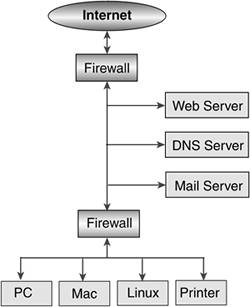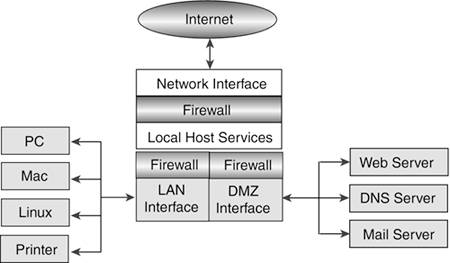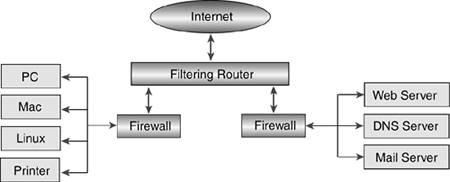Basic Gateway Firewall Setups
| Two basic gateway firewall setups are used here. As shown in Figure 6.1, the gateway has two network interfaces: one connected to the Internet and one connected to the DMZ. Public Internet services are offered from machines in the DMZ network. The gateway firewall offers no services. A second firewall, a choke firewall, is also connected to the DMZ network, separating the internal, private networks from the quasi-public server machines in the perimeter network. Private machines are protected behind the choke firewall on the internal LAN. Additionally, each of the server machines in the DMZ runs a specialized firewall of its own. If the gateway firewall or one of the servers fails, the public server machines in the DMZ continue to run their individual firewalls. The choke firewall protects the internal LAN from a compromised gateway or from any other compromised machine in the perimeter network. Traffic between the LAN and the Internet passes through both firewalls and crosses the perimeter network. Figure 6.1. A DMZ between a dual-homed gateway and a choke firewall.
In the second setup, the gateway has three network interfaces: one connected to the Internet, one connected to the DMZ, and one connected to the private LAN. As shown in Figure 6.2, traffic between the LAN and the Internet, and traffic between the DMZ and the Internet, share nothing except the gateway's external network interface. Figure 6.2. A tri-homed firewall separating a LAN and a DMZ.
An advantage of this configuration over the first is that neither the LAN nor the DMZ shares the traffic load of both networks. Another advantage is that it's easier to define rules that refer to all LAN or DMZ traffic specifically, as opposed to traffic related to the other network. Another advantage is that a single-gateway host is less expensive than two separate firewall devices. The disadvantage of this configuration over the first is that the gateway becomes a single point of failure for both networks. Also, the firewall rules in the single host include all the complexity related to both the DMZ and the LAN. This complexity can become a confusing issue when you're developing firewall rules by hand. A common third alternative is to add a filtering router that separates LAN and DMZ traffic. DMZ servers run their own bastion firewalls. There may or may not be a generalized firewall between the router and the DMZ. As shown in Figure 6.3, the gateway firewall is separate from the router and protects the LAN. The filtering router performs some of the basic filtering for both the LAN and the DMZ. The gateway firewall doesn't need to provide this basic filtering, and it effectively functions similarly to the choke firewall in the first setup. Figure 6.3. A filtering router in front of LAN and DMZ firewalls.
|
EAN: 2147483647
Pages: 163


